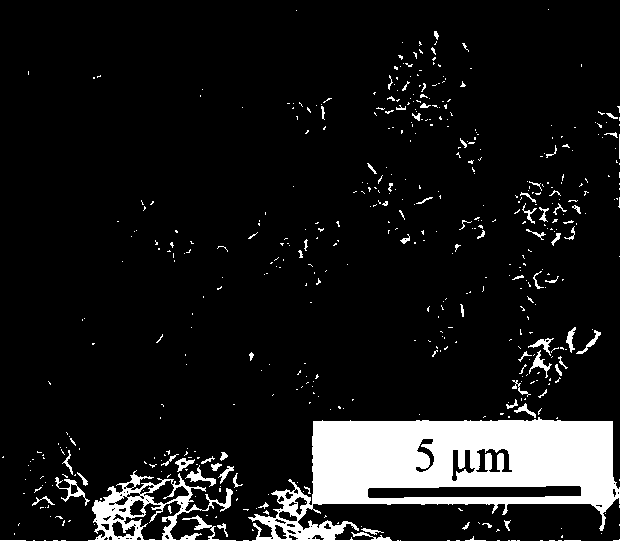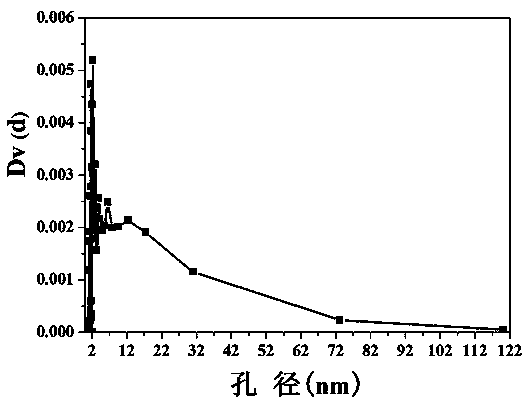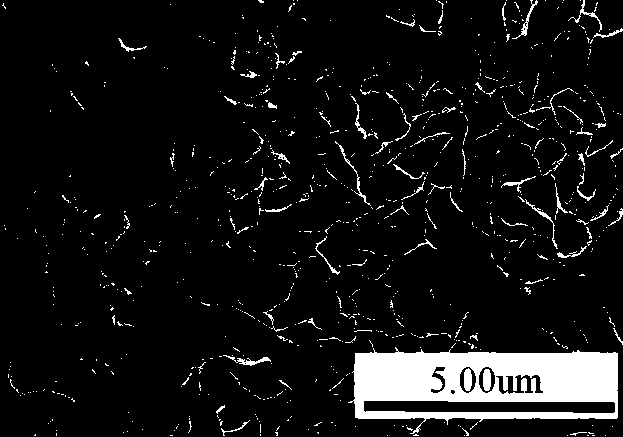Preparation method of porous glass ceramic with photocatalysis function crystal phase and obtained product
A photocatalysis and crystal phase technology, applied in the field of porous materials, can solve the problems of low content and impure crystal phase, and achieve the effects of high specific surface area, adjustable crystal phase, and easy control of the production process.
- Summary
- Abstract
- Description
- Claims
- Application Information
AI Technical Summary
Problems solved by technology
Method used
Image
Examples
Embodiment 1
[0031] 1. According to 4.76 mol% Fe 2 o 3 , 23.81 mol% MgO, 28.57 mol% CuO, 14.29 mol% TiO 2 and 28.57 mol% P 2 o 5 The molar composition of selected raw materials, Fe 2 o 3 , MgO, CuO, TiO 2 and P 2 o 5 The raw material for each oxide itself. Mix all the above-mentioned oxide raw materials uniformly to obtain a mixture.
[0032] 2. Put the mixture in step 1 into the crucible, and raise the temperature from room temperature to 600 °C at a rate of 10 °C / min, then from 600 °C to 1100 °C at a rate of 5 °C / min, and finally at 3 °C The heating rate per minute was raised from 1100 °C to 1250 °C, and kept at this temperature for 1 h to completely melt the mixture, pour the molten sample into cold water for quenching, and obtain a granular sample. Place in an oven at 100 °C for 12 h to dry.
[0033] 3. Raise the temperature of the sample to 630 ℃ at a rate of 5 ℃ / min, and keep it for 1 hour, then raise the temperature from 630 ℃ to 690 ℃ at a rate of 5 ℃ / min, and keep it fo...
Embodiment 2
[0038] 1. According to 4.76 mol% Fe 2 o 3 , 23.81 mol% MgO, 28.57 mol% CuO, 14.29 mol% TiO 2 and 28.57 mol% P 2 o 5 The molar composition of selected raw materials, Fe 2 o 3 , MgO, CuO, TiO 2 and P 2 o 5 The raw material for each oxide itself. Mix all the above-mentioned oxide raw materials uniformly to obtain a mixture.
[0039] 2, with embodiment 1.
[0040] 3. Raise the temperature of the sample to 630 ℃ at a rate of 5 ℃ / min, and keep it for 1 hour, then raise the temperature from 630 ℃ to 690 ℃ at a rate of 5 ℃ / min, and keep it for 2 hours. After the heat preservation, the samples were cooled to room temperature with the furnace.
[0041] 4. Soak the sample obtained in step 3 in 3 mol / L hydrochloric acid at 100 °C for 24 hours, take out the sample and dry it.
[0042] 5. The product obtained after drying is a single anatase titanium dioxide (TiO 2 ) crystalline porous material.
[0043] From figure 1 It can be seen that the crystal phase obtained by the prod...
Embodiment 3
[0045] 1. According to 6.98 mol% Fe 2 o 3 , 23.25 mol% MgO, 27.91 mol% CuO, 13.95 mol% TiO 2 and 27.91mol% P 2 o 5 The molar composition of selected raw materials, Fe 2 o 3 , MgO, CuO, TiO 2 and P 2 o 5 The raw material for each oxide itself. Mix all the above-mentioned oxide raw materials uniformly to obtain a mixture.
[0046] 2. Put the mixture in step 1 into the crucible, and raise the temperature from room temperature to 600 °C at a rate of 10 °C / min, then from 600 °C to 1100 °C at a rate of 5 °C / min, and finally at 3 °C The heating rate was increased from 1100 °C to 1250 °C per min, and kept at this temperature for 1 h to completely melt the mixture, and the molten sample was quenched and pressed into tablets to obtain an opaque black block sample, and then the sample was placed in Dry in an oven at 100 °C for 12 h.
[0047] 3. Raise the temperature of the sample to 605 °C at a rate of 5 °C / min, and keep it for 1 h, then raise the temperature from 605 °C to 68...
PUM
| Property | Measurement | Unit |
|---|---|---|
| pore size | aaaaa | aaaaa |
| pore size | aaaaa | aaaaa |
| pore size | aaaaa | aaaaa |
Abstract
Description
Claims
Application Information
 Login to View More
Login to View More - R&D
- Intellectual Property
- Life Sciences
- Materials
- Tech Scout
- Unparalleled Data Quality
- Higher Quality Content
- 60% Fewer Hallucinations
Browse by: Latest US Patents, China's latest patents, Technical Efficacy Thesaurus, Application Domain, Technology Topic, Popular Technical Reports.
© 2025 PatSnap. All rights reserved.Legal|Privacy policy|Modern Slavery Act Transparency Statement|Sitemap|About US| Contact US: help@patsnap.com



